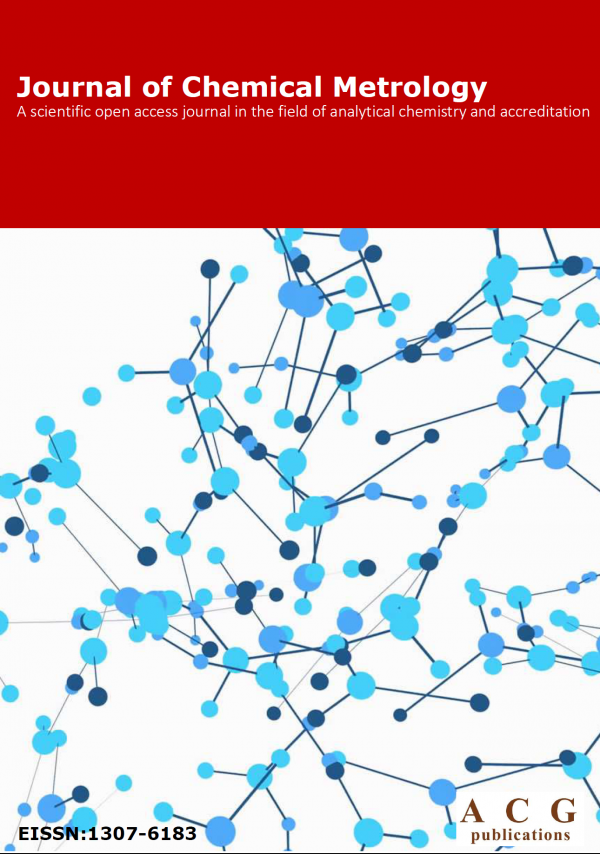Journal of Chemical Metrology
Year: 2010 Volume: 4 Issue:1
1) Development and validation of stability indicating UPLC method for the simultaneous determinationof beta-blockers and diuretic drugs in pharmaceutical dosage forms
With the objective of reducing analysis time and maintaining good efficiency, there has been substantial focus on high-speed chromatographic separations. In this work, rapid, precise and specific stability indicating ultra performance liquid chromatography (UPLC) method has been developed and validated for the simultaneous determination of beta-blockers and diuretic drugs in pharmaceutical formulations. The chromatographic separations of all the drugs were achieved on a Waters Acquity BEH C18, 50×2.1 mm, 1.7 µm UPLC column within a short runtime of 3.3 min. The newly developed method was validated according to the ICH guidelines with respect to specificity, linearity, accuracy, precision and robustness. Forced degradation studies were also performed for all the drug samples to demonstrate the stability indicating power of the developed UPLC method. Two unknown degradants were detected in the alkaline degradation of Amiloride hydrochloride with sodium hydroxide having not been reported previously. The structure of the degradants was determined using a combination of UPLC/MS and mechanistic chemistry. This degradant result from destruction of the guanidine moiety of amiloride hydrochloride. The two impurities were characterized as 3,5-diamino-6-chloropyrazine-2-carboxylic acid (impurity A) and 3-chloropyrazine-2,6-diamine (impurity B), respectively. Comparison of system performance with conventional HPLC was made with respect to analysis time, efficiency and sensitivity.
Keywords UPLC Beta-blockers Diuretic Simultaneous determination validation DETAILS PDF OF ARTICLE © 2010 ACG Publications. All rights reserved.2) Validated spectrophotometric methods for simultaneous estimation of Paracetamol , Domperidone and Tramadol HCl in pure and tablet dosage form
Two methods are developed for simultaneous estimation of paracetamol, domperidone and tramadolHCl in pure and tablet dosage form by using 0.1N NaOH as a solvent. Paracetamol, domperidone and tramadol HCl show absorbance maximums at 256 nm, 289.6 nm and 218.4 nm respectively. Shimadzu UV 1700, capable of multicomponent analysis, was used for quantitation. In method I, absorbance of the sample solution was measured at 256 nm and 289.6 nm for the estimation of paracetamol, domperidone respectively as tramadol HCl does not absorb at these wavelengths. Estimation of tramadol HCl was carried out at 218.4 nm. Method II is based on a multiwavelength spectroscopic method. Validation study reveals that the methods are specific, accurate, precise, and reproducible. All three drugs obey Beer's law in the concentration ranges used for the methods. Validation studies are statistically significant as all the statistical parameters are within the acceptance range (% COV< 2.0 and S.D. < 2.0) for both accuracy and precision study. High recovery and low % COV reveals the reliability of the method for quantitative study of three drugs in tablet formulation. The methods are simple, rapid accurate, precise, reproducible, and economic and can be used for routine quantitative analysis of paracetamol, domperidone and tramadol HCl in pure and tablet dosage form.
Keywords multi-wavelength spectroscopy paracetamol domperidone tramadol HCl. DETAILS PDF OF ARTICLE © 2010 ACG Publications. All rights reserved.3) A Rapid Densitometric Method for Quantification of Wedelolactone in Herbal Formulations using HPTLC
Wedelolactone possesses a wide range of biological activities and is used for the treatment of hepatitis, cirrhosis. A simple HPTLC method has been developed for the quantification of wedelolactone. The samples were dissolved in methanol and linear ascending development was carried out in twin trough glass chamber saturated with mobile phase consisting of toluene: ethyl acetate: acetone: formic acid (6:2:1:1v/v/v/v). Spectrodensitometric scanning was performed by TLC scanner III (CAMAG) in absorbance mode at the wavelength of 351nm.The system was found to give compact spots for wedelolactone (Rf value of 0.39 ± 0.03). The linear regression analysis data for the calibration plots showed good linear relationship with r2 = 0.9963 in the concentration range 400-800 ng/spot with respect to peak area. According to the ICH guidelines the method was validated for accuracy, precision, recovery, and robustness. The wedelolactone content quantified from herbal formulations was found well within limits. Statistical analysis of the data showed that the method is reproducible and selective for the estimation of wedelolactone.
Keywords HPTLC Wedelolactone Herbal formulations DETAILS PDF OF ARTICLE © 2010 ACG Publications. All rights reserved.